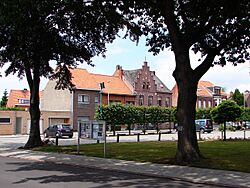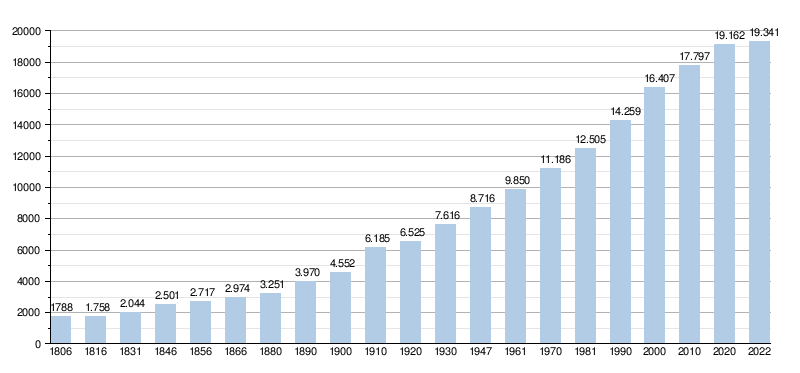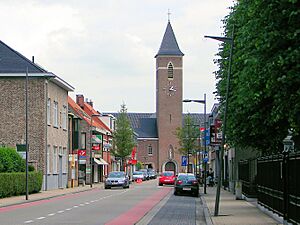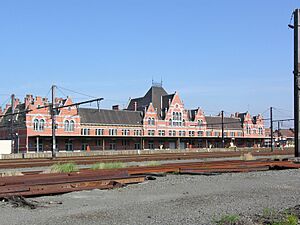Essen, Belgium facts for kids
Quick facts for kids
Essen
|
|||
|---|---|---|---|
 |
|||
|
|||
| Country | Belgium | ||
| Community | Flemish Community | ||
| Region | Flemish Region | ||
| Province | Antwerp | ||
| Arrondissement | Antwerp | ||
| Area | |||
| • Total | 47.48 km2 (18.33 sq mi) | ||
| Population
(2018-01-01)Lua error in Module:Wd at line 1575: attempt to index field 'wikibase' (a nil value).
|
|||
| • Total | Lua error in Module:Wd at line 1,575: attempt to index field 'wikibase' (a nil value). | ||
| Postal codes |
2910
|
||
| Area codes | 03 | ||
| Website | www.essen.be | ||
Essen is a town and municipality in Belgium. It's in the province of Antwerp. What makes Essen special is that the Netherlands borders it on three sides!
As of September 2022, about 19,029 people live here. Essen is part of the electoral canton of Brecht and the judicial canton of Kapellen. It's also in the Noorderkempen region.
Contents
What's in a Name?
The name "Essen" has changed over time. It used to be called "Esshen," "Essche(n)," and "Esse." These names might mean "high fields near water." Or they could mean "settlements along a stream."
Another idea is that the name comes from the ash tree. An ash tree is called "es" in Dutch. Long ago, ash wood was used to build ships. So, the name might mean 'boat made of ash wood' in Old Dutch.
A Look Back in Time
Early Days
People have lived in the Essen area for a very long time. We know this from old tools found there. About 8,500 years ago, groups of people moved around this region. They made tools like flint arrowheads. We don't have many sites, so it's hard to know more about them.
Tongerlo Abbey's Influence
In 1159, a man named Berner van Rijsbergen gave Essen to Tongerlo Abbey. An abbey is like a monastery. The abbey shared control of Essen with the Dukes of Brabant. Essen, along with Kalmthout and Huijbergen, was ruled by the abbey. This lasted until the French Revolution.
Times of Trouble
Essen faced tough times in the 1500s. It was attacked and robbed twice. First, in 1542, by soldiers led by Maarten van Rossum. Then, in 1583, by forces under Marshal Armand de Gontaut-Biron.
Becoming a Border Town
In 1795, Essen became independent. It took on the coat of arms of Prelate Hermans. He was the last abbot of Tongerlo. The coat of arms has two ox heads and a lamb. These symbols show the town's farming past. They also stand for being strong and patient.
In 1802, Essen became its own church parish. Before that, it was part of the Nispen parish.
The Belgian Revolution
After Napoleon lost in 1815, Essen became part of the United Kingdom of the Netherlands. William I of Orange-Nassau was in charge. But in 1830, the southern part of the Netherlands broke away. This created modern-day Belgium. Essen then became a border town.
There was a big fight called the Battle of Essen on November 21, 1830. This was during the Belgian War of Independence. After Belgium became independent, soldiers from Wallonia guarded the new border.
On November 20, 1831, these soldiers moved to Roosendaal. The next day, Dutch soldiers reacted strongly. About 4,000 Dutch soldiers entered Essen during a church service. They searched the town. Five soldiers and two villagers died. This sad event is known as the Battle of the Hill.
Growing with the Railway
On July 9, 1852, Belgium and the Netherlands made an agreement. They decided to build a new railway. This railway would connect Antwerp and Rotterdam. It was built between 1852 and 1854. The Antwerp-Lage Zwaluwe line had a key border station in Essen.
The railway helped Essen grow. It created many jobs. The station became a must-stop for international trains. Today, you can take an Intercity (IC) train from Essen to Antwerp and Brussels. There's also a local train to Roosendaal.
Since 1896, the border station has had quarantine stables. These were used to check cattle for diseases. This continued until the 1970s. In 1994, these stables became a protected monument.
World War I
During the First World War, Essen was cut off. German soldiers built a deadly barrier called the "Wire of Death." This wire is remembered in many artworks in Essen. The Netherlands stayed neutral and built similar barriers. Even with these barriers, people still smuggled goods in the area.
World War II
At the end of the Second World War, German forces caused a lot of damage. Several churches were destroyed. These included O.-L.-V. Geboortekerk in Essen-Centre. Sint-Jan-Baptistkerk in Wildert and Sint-Vincentius-à-Paulokerk in Horendonk were also ruined. They were seen as important lookout points.
Only a few churches were saved. These were the Eucharistic Heart Church, St. Anthony of Padua Church, and St. Peter's Church. Essen also got hit by V1 and V2 rockets. These rockets were meant for the port of Antwerp.
After the Wars
In 1959, a new customs office was built. It was on the same spot where the O.-L.-V. Geboortekerk once stood. Essen was the second busiest road customs office on the Belgian-Dutch border. Only Wuustwezel was busier. The office closed on January 1, 1993.
Since 1976, Essen has been partners with Essen in Oldenburg, Germany.
In 1977, local government areas were changed. Essen-Hoek was formed. Hoek had been around for centuries. But it was split into Kalmthoutsehoek and Essen-Hoek. This change made things simpler.
Where is Essen?
Essen is the third most northern municipality in Belgium. It is next to the municipality of Kalmthout. The rest of its borders are with the Netherlands. Essen is shaped like a "hump." It's the most northwestern town in the Kempen region. It's also the northernmost in Noorderkempen.
Parts of Essen
Essen doesn't have formal boroughs. But it has many neighborhoods and hamlets. The main part is "Essen-Centre." To the west is Heikant. Then comes Essen-Hoek, a rural area. Horendonk is east of the center. Wildert is to the south. Statie district is west of the center.
In 1977, Essen got a piece of Kalmthoutse Hoek. This part became part of Essen-Hoek.
Neighborhoods
Essen has two main districts: Essen-Centre and Essen-Statie. These districts have many smaller neighborhoods. Some of them are De Heuvel, De Donk, Spijker, Zandstraat, Werf, Bredestraat, Schanker, Schriek, Steenpaal, Vennen, Schildershof, Hemelrijk, Statievelden, and Hondsberg.
Nearby Towns
- North: Roosendaal (NL), Ruchphen (NL)
- East: Zundert (NL)
- South: Kalmthout (BE)
- West: Woensdrecht (NL)
Cool Places to See
- The Kiekenhoeve: An old farm from 1776. It's near the Wheelbarrow museum.
- The Quarantine Stables: Animals were kept here until the 1970s. They were checked for diseases. It's now a protected monument.
- Essen railway station: An important border station.
- The old SNCB goods shed: Close to the railway station.
- Some old mansions: You can find them in the Nieuwstraat.
- The old presbytery: This was home to priests for 500 years. It's now a cultural center. It was first mentioned in 1362.
- The Eucharistic Heart Church: This church is part of a college. It has a 4.5-meter tall copper Sacred Heart statue. There's also a Lourdes grotto in the garden.
- The Bakersmill: Built in 1981 in Wildert. It's the newest mill in Flanders.
- The Mill of Aerden: What's left of an old windmill.
- The St. Anthony of Padua Church: Designed by architect Jules Bilmeyer.
- The Church of Our Lady of Grace.
Museums to Visit
- The Karrenmuseum: A museum about carts and wagons.
- The Gerard Meeusen museum: Located in the attic of the town hall.
- The steam museum: Found in the Bakkersmolen.
- Robotland: A fun technology center next to the station.
- 't Kniphof: A museum about paper cutting art.
Nature Spots
Several streams flow through Essen. The longest one is the Kleine Aa. It flows from the south and then along the east side of Essen.
Waterways
- Molenbeek
- Biezebeek
- Papenmoerbeek
- Old Moervaart
- Spillebeek
- Kleine Aa or Wildertse Beek
- Roosendaalse Vaart
Natural Areas
- The Forest Museum Wildert Dunes
- The Horendonk Woods or Essen Dunes
- The Redemptorist Fathers' Park or the Father's Garden
How Many People Live Here?
Population Growth

- Sources: NIS, Note:1806 through 1981=population censuses; 1990 and later=population on January 1
As of October 2017, Essen has over 19,000 people. Almost one out of five people in Essen is from the Netherlands.
Fun and Culture
Music
- Kommil Foo: A famous cabaret duo.
Events
- Carnival: The biggest parade in the Noorderkempen area.
- Hoekse Kermis: A fun fair in early July with traditional games.
- Pumpkin Festival: Held on the first Sunday in October, with a pumpkin parade.
- Wildert Fun Fair: Happens in October.
- Owl Fair: A four-day event in September with games.
- Craft Day: On the last Sunday of August.
- Christmas Beer Festival: An international event in mid-December.
- Youth groups in Essen also have their own yearly events.
Churches in Essen
Essen is part of the deanery of Noorderkempen. This is in the diocese of Antwerp. There are many churches here, including:
- Church of Our Lady of the Nativity in Essen-Centre
- St Anthony of Padua church in Essen-Statie
- St John Baptist church in Wildert
- Verrezen Heerkerk in Heikant
- St Peter's church at Essen-Hoek
- St Vincent de Paul church in Horendonk
- Eucharistic Heart Church: This church is part of a monastery. It is no longer used for services.
Getting Around
Roads
Four main roads go through Essen. They are the N125, N117, N122, and N133.
Public Transport
Essen has two train stations. The main station is on the line between Antwerp and Roosendaal. Local trains run between Roosendaal and Antwerp-Central. On weekdays, an IC-train goes from Essen to Brussels and Charleroi. The village of Wildert also has its own train station.
You can also take a bus from Essen. Bus line 670 goes to Kapellen. Bus line 674 goes to Stabroek, passing through Wildert.
Sports
Essen has four football clubs:
- Excelsior FC Essen
- KFC Olympic Essen
- Horendonk FC
- KSV Wildert
Sports Events
- The Ronde van Essen: A running race held in the last week of August. Each day, it's in a different part of Essen.
- IKO cyclocross: A bike race organized at the Hemelrijk.
Famous People from Essen
Many well-known people were born or live in Essen. Some also have strong ties to the town:
- Bart Aernouts: A cyclocross rider.
- Pieter Andriessen: A music expert.
- Pam Cornelissen: A Dutch politician.
- Sachli Gholamalizad: An actress and theater maker.
- Jef van Gool (1935-2022): A soccer player.
- Jan Goossenaerts: From 2010 to 2012, he was the oldest man in Belgium and Europe.
- Rose Gronon: A poet.
- Ditte Jaspers: An actress.
- Hubert Lampo: A writer.
- Ludo Loos: A cyclist.
- Gustave Magnel: An engineer and professor.
- Tom Meeusen: A cyclo-cross rider.
- René Melis: A journalist and writer.
- Paul Pauli: A painter and writer.
- Michiel Rampaart: An actor.
- Zdeněk Štybar: A cyclo-cross rider.
- Herman Suykerbuyk: A politician.
- Dries van Noten: A fashion designer.
- Cara Van der Auwera: A singer, actress, and presenter.
- Inga Verhaert: A politician.
- Mich and Raf Walschaerts: Cabaret artists from Kommil Foo.
- Hannes Delcroix: A footballer.
- Frank Focketyn: An actor.
- Philip Braat: A Scottish Labour politician.
Partner Cities
Essen has friendly ties with several cities around the world:
- Essen (Oldenburg) (Germany)
- Šilalė (Lithuania)
- Žilina (Slovakia)
- Hradištko (Czech Republic)
- Witzenberg (South Africa)
- Bolekhiv (Ukraine)
Nearby Towns
- Horendonk
- Nispen
- Essen-Hoek
- Wildert
- Nieuwmoer
Images for kids
See also
 In Spanish: Essen (Bélgica) para niños
In Spanish: Essen (Bélgica) para niños









